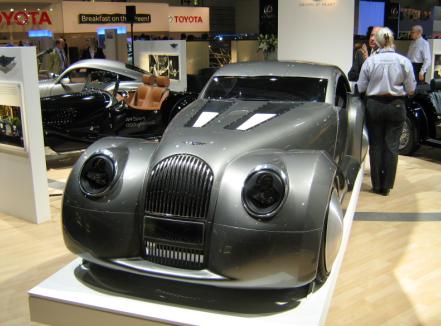Original URL: https://www.theregister.com/2008/07/22/morgan_lifecar_hydrogen_displayed/
Morgan shows 'light & slippery' fuel-cell car concept
Wood, leather and hydrogen - a fiery combo?
Posted in Science, 22nd July 2008 12:00 GMT
Here at the Reg we aren't motoring hacks, we're technology hacks. So to us, most of the cars here at the British Motor Show are a bit boring. Internal-combustion engine? Come on. Battery car? Needs to be special. Hydrogen fuel cell? Even Nigel Tufnel has one (shared with his less famous wife, Jamie Lee Curtis). Anyway, fuel-cell cars are always battery hybrids.

Hydrogen motoring - it's all about how light and slippery you are
But wait - actually they're not. Also on show here today is the LifeCar, a concept from famously eccentric British luxury handbuild firm Morgan. The LifeCar, unusually for a fuel-cell design, has no battery pack at all. Its PEM fuel cell stack is rather small, too, rated for only 22 kilowatts of electric output: a measly 30 horsepower or so. And yet Morgan expects to get 0-60 mph in seven seconds and top speed of 90 mph. How?
"It's all about using the right amount of power for the job," Morgan marketing director Matthew Parkin told The Reg today. "With a car this light and this slippery, 30 horsepower is plenty."
Morgan believe that current fuel-cell designs are much too heavy, hauling too much load about in the form of batteries, which then means that they need a lot of fuel cells, which means even more weight.
Even so, there's no way that fuel cell drive alone can deliver the acceleration that's promised for the LifeCar. It has to store power somehow, and it does - using ultracapacitors. Ultracapacitors hold only a fraction of the power that batteries do, but they can take it in and give it out again much faster.
The idea of the LifeCar is that the extra boost from the ultracapacitors will only be needed for seconds at a time. While driving at any speed the fuel cells will seldom have power to spare for topping off the ultracapacitors, but Morgan plans to exploit their ability to charge up very fast by using highly efficient regenerative braking. According to Parkin, the LifeCar will recover 50 per cent of the kinetic energy forfeited as it slows down, rather than ten per cent as in most current hybrids and battery vehicles.
The lightweight and slinky car will waste far less energy accelerating, overcoming friction and slowing down than others do, goes the thinking, and thus won't need so much power over time from the prime mover - the fuel cell. According to the tech spec, the LifeCar gets much of its lightness from traditional Morgan materials - "aluminium, wood and leather".
Morgan see the concept as more elegant than all-battery or hybrid designs, and point to the possible metallic-pollution waste burdens of battery-intensive designs. And Parkin isn't concerned about the future availability of hydrogen filling stations.
"There are plenty of people offering small-scale hydrogen filling points," he says. "If you want it enough, you can have it in your home. Our customers will be able to get hydrogen if they need it."
He's surely right in the case of Morgan customers, who tend to be well-off, motivated and possessed of off-street parking facilities. He could even be right in the case of ordinary motorists: Honda, the main proponents of fuel-cell motoring in the mainstream car world, are experimenting with various kinds of home hydrogen station. Originally, these were expected to use solar power to crack hydrogen cleanly from water, a method whose green credentials would have been unassailable.
However, even in sunny California this didn't seem to go well - the Japanese motor behemoth is now focusing more on the current industrial method of making hydrogen, that is by steam reforming with natural gas.
This latter concept is much less eco-friendly: in effect your Honda FCX or Morgan LifeCar has now become a carbon-emitting gas-powered vehicle, and not necessarily a very efficient one. The car itself may beat the low efficiency of internal combustion (Morgan claim 45 per cent for their fuel cell and low-nineties for the motors), but there are other losses in the reforming and compressing processes.
Morgan seem relatively unconcerned about the bigger issues, however.
"We don't know what method is best," says Parkin. With the LifeCar, Morgan are exploring ideas rather than hoping to mould the entire future of world motoring. So when might it be available to buy?
"We could be ready to sell in two to three years," says Parkin. Asked about price, he said: "I absolutely don't know... couldn't say. I've seen the figure £150,000 in the press, but that is completely made up. It would depend entirely on the level of interest."
Morgan hand builds every car, so it would be perfectly normal for them to make a hundred LifeCars or even fewer as a profit-making piece of business. The company has done such limited-edition models before, and in such cases prices have been well north of £100k. But if the LifeCar is made in larger numbers, it might well be cheaper. If this were GM talking, one might file the LifeCar under concepts-which-won't-get-built, like the Provoq: but there's really not that much difference between concept cars and production models at Morgan.
And if you'd prefer some other kind of concept, says Parkin, they might build it. The LifeCar that actually reaches the roads may be quite different from the way it seems now. Particularly when it comes to the post fossil fuel, ecological motoring world, Parkin himself suspects that there may intially be many different kinds of vehicle doing different jobs.
"After all," he says cheerfully, "everyone should have more than one car anyway, for different kinds of driving. That's just common sense."
That may be something of a niche viewpoint - but then Morgan are a niche company. ®